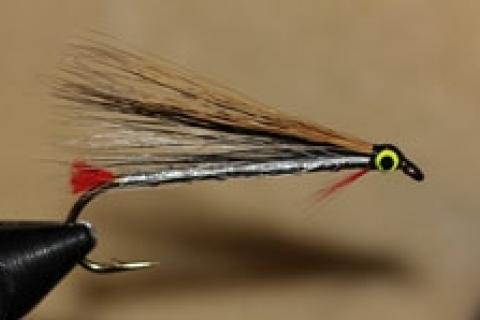
The Black Nose Dace is one of those special fly patterns that fly fisherman have favored for years on end. This streamer pattern was created by Art Flick in the early 1950s and works when nothing else will. Many large trout across the country get caught by this sultry streamer as it is swung near their feeding zone. Aside from its immediate attraction to fish, the Black Nose dace is also great searching pattern as anglers fishing the swing can cover large amounts of productive water over the course of a day.
The Black Nose Dace is one of the best imitations to date of the Rhinichthys species. This minnow is one of the most commonly found minnows throughout the streams and rivers in North America. Typically these minnows range in size from 2 to 3 inches long and have a characteristic black lateral line running from the tip of their noses to their tail. In addition dace have a brownish color across the back and white in the belly. Depending on the time of the year and water color conditions, some dace will develop orange or red highlights on their fins and underbody as they spawn.
The Black Nose Dace streamer is a relatively easy tie for the beginner or advanced fly tier. Art Flick's pattern was originally tied with white, black and brown bucktail with a short, red yarn tail and silver tinsel body. Tiers sometimes substitute synthetic materials in their recreations of Art's dace pattern but although using natural materials might not look as good or handle as easy as synthetics they are none the less potent with fish.
This fly can be fished a few different ways with great results. Dead drifting the Black Nose Dace Pattern can be productive when trout are actively feeding on minnows for example after a heavy rain. Also swinging this pattern through long runs or near ambush spots is a great way to entice larger trout to chase your fly. Timely strips or line during the swing or dead drift can also lure that lunker into biting.
Materials List
| Hook | White River Fly Shop Streamer Hook, Size 4 |
| Thread | Black Uni Thread 8/0 |
| Head | Black Uni Thread 8/0 |
| Tail | Red Yarn |
| Body | Silver tinsel |
| Rib | Round silver tinsel |
| Wing | Bucktail (Brown/Black/White) |
| Throat | Red Saddle Hackle |
Step-by-Step Tying Instructions
| Step 1 Start this fly by placing the hook into the vice and securing in place tightly. Attach the thread to the hook shank behind the hook eye. | |
| Step 2 Cut a two inch strip of red yarn and wrap it down with thread until you reach the point above the barb. Advance the thread to the front of the hook shank. Cut the tag end of the yarn off close to the hook shank. | |
| Step 3 Cut a three inch strip of round silver tinsel and wrap it down with thread until you reach the point above the barb. Advance the thread to the front of the hook shank. | |
| Step 4 Tie in four inch strip of flat silver tinsel and wrap it evenly towards the rear of the hook and then back to the front. Make sure to wrap slightly over the edge of the tinsel in successive wraps so that none of the thread underbody can be seen below. | |
| Step 5 Counter wrap the round silver tinsel up the body of the fly (7-8 turns to spank the hook shank) and tie off behind the hook eye. | |
| Step 6 Turn your vice upside down (if you have a rotary vice) or flip your hook around in your vice. Clip a small bunch of red saddle hackles and tie them to the hook shank extending towards the rear of the fly. | |
| Step 7 Flip the fly back over and cut three small bunches of bucktail fibers (brown, black and white).Place the white buck tail in your hair stacker and align the tips. Tie this group of fibers to the top of the hook shank extending to the tip of the red tail. | |
| Step 8 Repeat this process for the black bucktail fibers. | |
| Step 9 Repeat this process for the brown bucktail fibers. | |
| Step 10 Build a small neat head with the black thread and cement. Attach a plastic eye to each side of the head with epoxy and then coat the entire head with cement. |
- 9305 views

